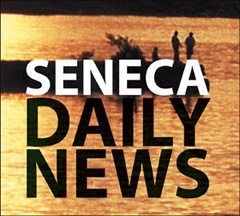White Man Contacts Before the Sullivan Campaign of 1779
This is another in a series of article by the Seneca County Historian’s office. Walt Gable of Seneca Falls is the current Seneca County Historian.
Missionary contacts
Jesuit missionary priests were the first white men to reach this area, carrying on their work in the period 1656 to 1684. They established missionary stations among the Cayuga nation. One of these was called St. Stephen and was located at the Indian village of Tiohero situated on the east side of Cayuga Outlet (Seneca River) a short distance from the north end of Cayuga Lake. Another was located at St. Rene (Onontare) near the present village of Savannah in the town of Galen, near the north boundary of the present-day Seneca County.[i]
In May 1656, Father Rene Menard accompanied a French expedition to Onondaga (near Syracuse today) and then to the Cayugas in August. He remained with the Cayugas for two months until he was recalled to Onondaga . Soon thereafter he returned and remained until the missions were broken up in 1657. The Free Bridge on Routes 5 and 20 is named the Father Rene Menard Bridge.
From a journal entry of Father Raffeix in 1671, we get an early white man’s report of the beauty of what is today Seneca County. Using the word “Goigouen†to refer to this area, he said the following:
Goiogouen is the fairest country I have seen in America. It is a tract between two lakes and not exceeding four leagues in width, consisting of almost uninterrupted plains, the woods bordering it are extremely beautiful. Around Goiogouen there are killed more than a thousand deer annually. Fish, salmon, as well as eels and other fish are plentiful. Four leagues from here I saw by the side of a river fine salt springs.[ii]
Two Moravian missionaries, Bishop Cammerhoff and Rev. David Zeisberger, passed through the territory in 1750. They visited the Onondagas, then the Cayugas near Union Springs, crossed Cayuga Lake and then proceeded on foot upon a short spiritual mission to the Seneca Indians.
Another missionary, the Rev. Samuel Kirkland, provided much insight into this area and the Indians. He made the acquaintance of Sir William Johnson, the British agent for Indian affairs, in the fall of 1764. In January 1765, escorted by two Senecas, he commenced a journey of some two hundred miles to the Senecas. He reports of the bitter cold and the snow so deep that snowshoes were required. On the twenty-third day of his journey, he reached Kanadaseagea (Geneva) which was then the capital of the Seneca Nation. He stayed there for eighteen months. He was adopted by the chief sachem. He was subjected to attempts to take his life. He became familiar with the language of the Senecas. He visited neighboring towns such as Skoi-yase. During the early years of the American Revolution, George Washington used Kirkland and his friendly scouts to obtain information about the Indians’ intentions and activities in this area. In 1779 he was a chaplain in the army of General John Sullivan and came to Kanadasaga with the army.[iii]
Other white men
A few traders with the Indians were also early visitors between Cayuga and Seneca Lakes prior to the American Revolution. One can easily imagine the Indians’ interests in securing blankets liquor, etc.
Trading had its advantages but the Indians did not want white settlers. The Iroquois became increasingly irritated over the white settlers taking the best lands along the Mohawk and upper Susquehanna Rivers. Sir William Johnson, Superintendent of Indian Affairs for the British, called a conference at Fort Stanwix (where Rome is today) in 1768 to make a treaty between Indians and the colonists. Chiefs and colonial leaders attended this conference from as far south as Virginia. After several weeks of meeting, a treaty was signed that forbade white settlers from settling west of a line that ran from Rome, NY south to the headwaters of the Delaware River and west of the Alleghany Mountains. For $10,000 and other gifts, the Indians gave up western Pennsylvania and Kentucky.[iv]
Sir William Johnson himself visited our area in 1769. He left his home in Johnstown on June 26, 1769, to visit the Senecas. He crossed Cayuga Lake near Canoga and proceeded to the Indian village of Skoi-yase (today’s Waterloo). Using a Senecas council site-under a group of six oak trees located at the foot of Locust Street-he held a council with the Cayugas and the Senecas. Johnson reports that “the Cayugas and Senecas here made known to him their grievances, the murder of their people by the whites, and frauds and abuses perpetrated upon them.â€[v]
The Iroquois were not happy with the various encroachments of whites into their upstate New York territory. The advent of the American Revolution forced the Iroquois to try to determine what was the best strategy to prevent further encroachments by white settlers.
[i] John C. Becker, A History of the Village of Waterloo, Waterloo: Waterloo Library and Historical Society, 1949, p 14.
[ii] Dr. James Sullivan, ed. The History of New York State, Book VII, Chapter IV, online edition www.usgennet.org/usa/ny/state/his/bk7/ch4.html
[iii] Becker, p 15.
[iv] Maurice L. Patterson, Between the Lakes, Interlaken: Heart of the Lakes Publishing, 1976, p 5.
[v] Becker, p 16.
Join Seneca Daily On Facebook HERE
Up to 75% off Blowout Sale on Selected Items at ZAGG.com. Check it out now.![]()









Leave a Reply